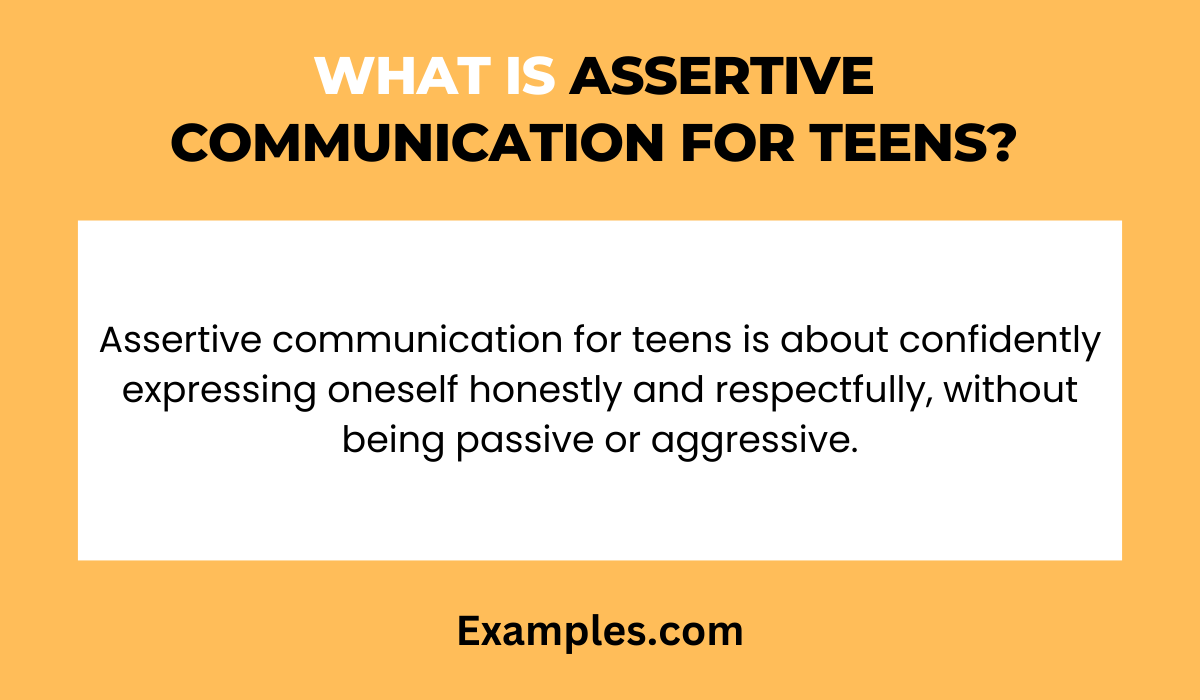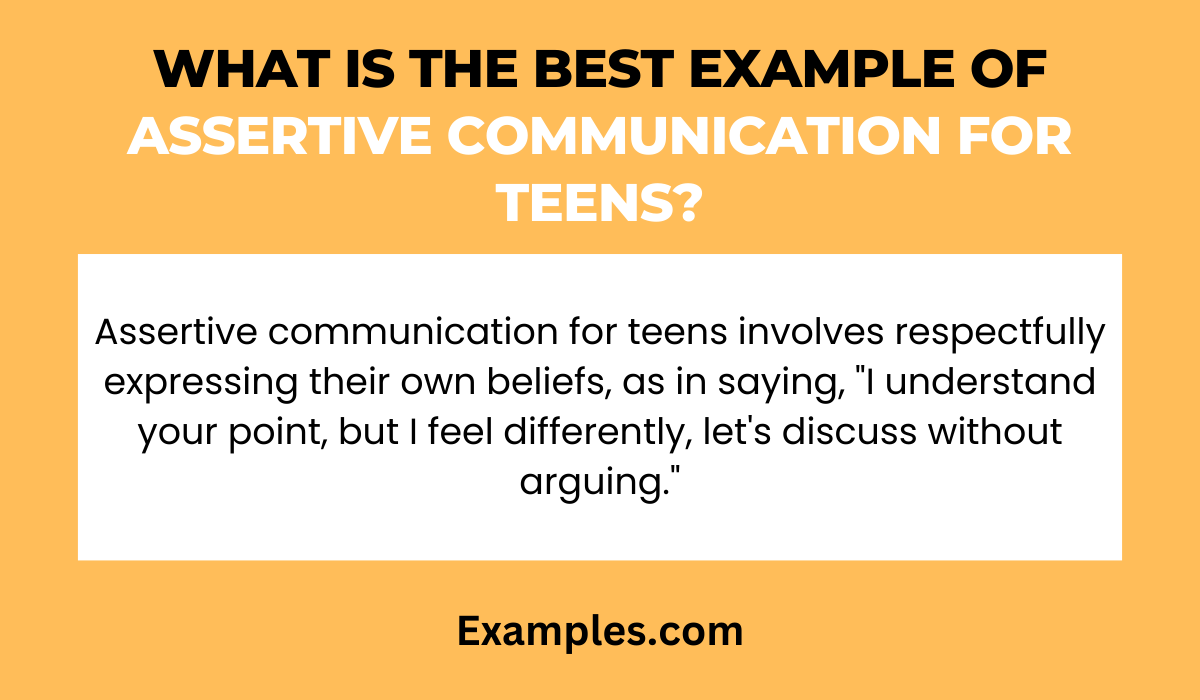19+ Assertive Communication for Teens Examples
Assertive communication is a vital skill for teens, bridging the gap between passive and aggressive styles. This guide delves into the nuances of assertive communication within the realm of oral communication, offering a rich collection of examples. It’s tailored to help teenagers articulate their thoughts and feelings confidently and respectfully, enhancing their interpersonal communication skills. Whether in school, at home, or in social settings, these examples and strategies empower teens to express themselves effectively, ensuring their voices are heard and their messages are conveyed clearly.
What is Assertive Communication for Teens?

Assertive communication for teens involves expressing one’s thoughts, feelings, and needs in a direct, honest, and respectful way. It’s about standing up for oneself without infringing on the rights of others. This communication style is crucial for teens as it helps them navigate complex social dynamics, build healthy relationships, and develop a strong sense of self. Assertive communication strikes a balance between being overly passive (not expressing personal needs) and overly aggressive (expressing needs in a hurtful or disrespectful manner), fostering positive interactions and self-confidence.
What is the Best Example of Assertive Communication for Teens?

The best example of assertive communication for teens often revolves around standing up for personal beliefs or needs in a respectful manner. For instance, a teen disagreeing with a friend about a sensitive topic can be assertive by saying, “I understand your point, but I feel differently about this issue. Can we discuss our views without arguing?” This approach shows respect for the other person’s opinion while confidently expressing their own. It demonstrates the ability to engage in healthy, constructive conversations, essential for personal development and maintaining positive relationships during the formative teenage years.
20 Assertive Communication for Teens Examples
Explore 20 distinct examples of assertive communication tailored for teens, designed to enhance their communication skills and confidence. This collection dives into various scenarios where teens can apply assertiveness, from handling peer pressure to expressing personal needs. Each example is crafted to be relevant, relatable, and effective, showcasing how teens can maintain respect while being clear and direct. These examples cover a wide range of contexts, including interpersonal communication, conflict resolution, and self-expression, making them ideal tools for teens looking to develop a balanced and effective communication style.
- Refusing Peer Pressure Politely:
Assertively declining unwanted activities while maintaining friendships.
Example: “I appreciate the invite, but I’m not comfortable with this, so I’ll have to pass.” - Requesting Clarification in Class:
Confidently asking for further explanation on a confusing topic.
Example: “I’m not clear on this part. Could you please explain it a bit more?” - Expressing Feelings to Family:
Openly sharing emotions with family members in a respectful way.
Example: “I feel upset when you go through my things without asking. Please respect my privacy.” - Negotiating Curfew with Parents:
Diplomatically discussing and adjusting rules with parents.
Example: “Can we talk about extending my curfew on weekends? I believe I’ve been responsible.”

- Handling Disagreements with Friends:
Tactfully addressing conflicts without harming friendships.
Example: “I understand your point, but I see it differently. Let’s find a middle ground.” - Speaking Up in Group Projects:
Contributing ideas confidently in a group setting.
Example: “I have a suggestion for our project. What if we try this approach?” - Responding to Bullying:
Standing up against bullying in a calm and firm manner.
Example: “It’s not okay to talk to me like that. Please stop.” - Requesting Help from Teachers:
Comfortably seeking assistance when needed.
Example: “I’m struggling with this topic. Could I get some extra help?” - Expressing Discomfort:
Letting someone know when their behavior is making you uncomfortable.
Example: “I don’t like it when you make jokes about that. Please stop.” - Setting Boundaries in Relationships:
Communicating personal limits clearly and respectfully.
Example: “I’m not ready for this step in our relationship. Let’s take things slower.” - Discussing Grades with Teachers:
Addressing concerns about academic performance constructively.
Example: “I was hoping we could discuss my recent test score. I’d like to understand where I went wrong.” - Handling Teasing from Siblings:
Responding to sibling teasing without escalating the situation.
Example: “I know you’re joking, but I don’t find that funny. Please stop.” - Navigating Friend Group Dynamics:
Expressing oneself when feeling left out or misunderstood in a friend group.
Example: “Lately, I’ve been feeling left out of our group activities. Can we talk about it?”

- Addressing Misunderstandings:
Clarifying misunderstandings in a clear and non-confrontational way.
Example: “There seems to be a misunderstanding. Here’s what actually happened…” - Giving Constructive Feedback:
Offering feedback that is helpful and not hurtful.
Example: “I think your presentation was good, but maybe you could try adding some examples next time.” - Declining Unwanted Advances:
Politely but firmly turning down unwanted romantic or social advances.
Example: “I’m flattered, but I’m not interested in dating right now.” - Asserting Opinions in Discussions:
Confidently sharing one’s opinions in class discussions or debates.
Example: “I have a different perspective on this topic. Here’s my viewpoint…” - Requesting Personal Space:
Politely asking for privacy or personal space when needed.
Example: “I need some time alone right now. Can we talk later?”

- Requesting a Change in Behavior:
Politely asking someone to modify their behavior that affects you.
Example: “I appreciate your humor, but I feel uncomfortable with jokes about my height. Can we avoid those?” - Expressing a Contrary Opinion:
Sharing a different viewpoint in a group discussion.
Example: “I see your point, but I have a different perspective on this topic. Here’s what I think…”
Assertive Communication Strategies for Teens
Effective assertive communication strategies for teens are crucial for their development and social interactions. Here are some key strategies:
- Expressing Needs Directly: Encouraging teens to express their needs and opinions directly and respectfully.
- Learning to Say No: Teaching teens to refuse requests that they are uncomfortable with or unable to fulfill.
- Understanding Body Language: Emphasizing the importance of nonverbal cues in conveying assertiveness.
- Developing Empathy: Fostering empathy to understand others’ viewpoints while asserting their own.
- Practicing Self-Respect: Encouraging teens to respect themselves in their communication, which is a core principle of assertive communication.
- Role-Playing Scenarios: Using role-play to practice assertive responses in different situations.
- Handling Criticism Constructively: Teaching teens to accept and respond to criticism in a constructive manner.
- Building Emotional Intelligence: Developing emotional intelligence to manage emotions effectively in communication.
Types of Assertive Communication for Teens
There are various types of assertive communication that teens can use in different contexts:
- Verbal Assertiveness: Expressing thoughts and feelings clearly and respectfully using words.
- Nonverbal Assertiveness: Using body language, such as posture and eye contact, to assert one’s stance.
- Emotional Assertiveness: Being able to express emotions in a calm and controlled manner.
- Constructive Assertiveness: Focusing on constructive and positive aspects while communicating.
- Situational Assertiveness: Adapting assertiveness according to the situation and the people involved.
- Passive Assertiveness: Asserting oneself in a softer tone, suitable for sensitive situations.
- Aggressive Assertiveness: Being firm in communication, often used in situations requiring immediate action or attention.
- Balanced Assertiveness: A combination of different assertive styles, adapting as per the need of the situation.
Why is Assertive Communication Important for Teens?
Assertive communication is crucial for teens for various reasons:
- Fosters Self-Confidence: Helps teens gain confidence in expressing their opinions and needs.
- Enhances Social Skills: Improves interpersonal skills, aiding in the development of healthy relationships.
- Reduces Peer Pressure: Equips teens with the ability to resist negative peer pressure and make independent decisions.
- Promotes Emotional Well-being: Assertive communication helps in managing emotions and reduces feelings of anger and frustration.
- Improves Academic and Career Prospects: Effective communication skills are essential for academic success and career development.
- Encourages Respectful Interactions: Promotes mutual respect in interactions with peers and adults.
- Aids in Conflict Resolution: Assertiveness is key in resolving conflicts in a healthy, constructive manner.
- Prepares for Adulthood: Provides a foundation for effective communication in adult life, both personally and professionally.
Assertive communication is an invaluable skill for teens, equipping them with the confidence and clarity needed for effective self-expression. This guide, with its rich examples and practical tips, serves as a roadmap for teens to navigate social interactions assertively. Embracing these techniques not only enhances personal relationships but also lays a strong foundation for their journey into adulthood.
In conclusion, assertive communication is a vital skill for teenagers, providing them with the necessary confidence and clarity for effective self-expression. This guide, enriched with practical examples and tips, serves as a comprehensive resource for teens to develop and refine their assertive communication skills. Such skills are not only crucial for enhancing personal relationships but also lay a solid foundation for successful interactions in their future adult life. To further enrich their understanding and practice of assertive communication, teens can explore resources like the American Psychological Association’s Assertive Communication Guide, which offers additional insights and techniques. Additionally, the Center for Parent and Teen Communication provides valuable advice and strategies specifically tailored for improving communication between teens and their parents, fostering a healthy and open dialogue.



